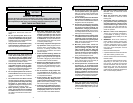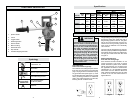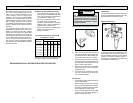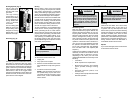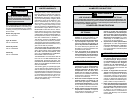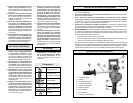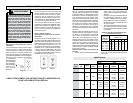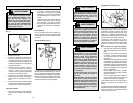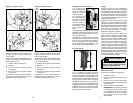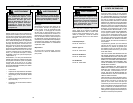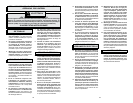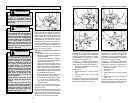
8
9
WARNING
To reduce the risk of injury, wear
safety goggles or glasses with side
shields. Unplug the tool before
changing accessories or making
adjustments.
OPERATION
WARNING
To reduce the risk of personal injury
when drilling, always hold tool by the
insulated gripping surfaces when
performing an operation where the
cutting tool may contact hidden wir-
ing or its own cord. Contact with a
"live" wire will make exposed metal
parts of the tool "live" and shock
the operator.
WARNING
When drilling with a single speed
drill or in HI with a two speed drill,
always hold the drill securely us-
ing the pipe handle, or brace the
drill against a solid xed object in
preparation for a sudden reaction.
When drilling in LO with a two speed
drill, always brace the drill against a
solid xed object in preparation for
a sudden reaction.
When drilling, never use your body
to brace drill.
Never put your hands (or other body
parts) between the part of the drill
being braced and the object it is be-
ing braced against. Hands (or other
body parts) that are in the path of the
reaction can be pinched, crushed
and broken.
Bracing for forward rotation
When drilling in forward, the bit will rotate in
a clockwise direction. If the bit binds in the
hole, the bit will come to a sudden stop and
drill will suddenly react in a counterclockwise
direction.
Figures 4 and 5 show examples of a Hole
Hawg
®
properly braced for forward rota-
tion.
A. Forward (clockwise) rotation
B. Reaction
C. Brace drill with pipe handle here
D. Brace drill with motor housing here
If the bit binds, the pipe handle or the motor
housing braced against the stud will hold the
drill in position.
Bit binding (Fig. 3)
If the bit binds, the drill will suddenly react
in the opposite direction of the rotation of
the bit. Figure 3 shows the path of reaction
(B) if the drill bit binds while being driven in
forward (A). The operator should reduce the
chances of a sudden reaction by following
the instructions listed below.
The operator should also prepare for a
sudden reaction by holding securely using
the pipe handle or bracing against a solid
xed object.
To reduce the chance of bit binding
• Use sharp bits. Sharp bits are less likely
to bind when drilling.
• Use the proper bit for the job. There are
many types of bits designed for specic
purposes.
• Use the proper speed for the size
bit. Larger bits should be run at the
lower speed. Driving larger bits at high
speeds will increase the chance of the
bit binding and increase the chance of
reaction.
• Avoid drilling warped, wet, knotty, and
or pitchy material if possible.
• Avoid drilling in material that you suspect
contains hidden nails or other things that
may cause the bit to bind.
The direction of reaction is always opposite
of the direction of bit rotation.
Reaction is even more likely to occur when
enlarging already existing holes and at the
point when the bit breaks through the other
side of the material.
B
A
Fig. 5
Fig. 4
Fig. 3
B
C
A
A
B
D
Bracing for reverse rotation
When drilling in reverse, the bit will rotate in
a counterclockwise direction. If the bit binds
in the hole, the bit will come to a sudden
stop and the drill will suddenly react in a
clockwise direction.
Figures 6 and 7 show examples of the
Hole Hawg
®
properly braced for reverse
rotation.
A. Reverse (counterclockwise) rotation
B. Reaction
C. Brace drill with pipe handle here
D. Brace drill with motor housing here
If the bit binds, the pipe handle or the motor
housing braced against the stud will hold the
drill in position.
Fig. 6
Fig. 7
B
C
A
A
B
D




